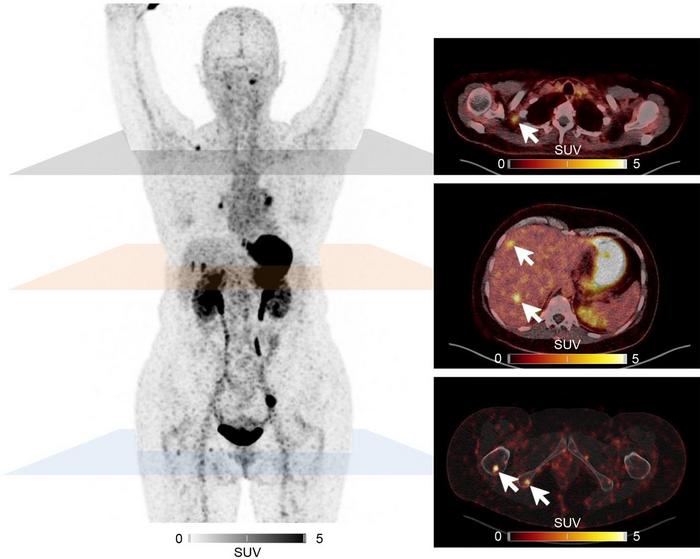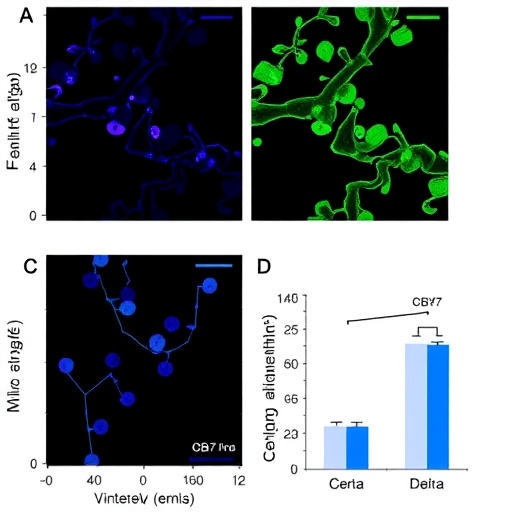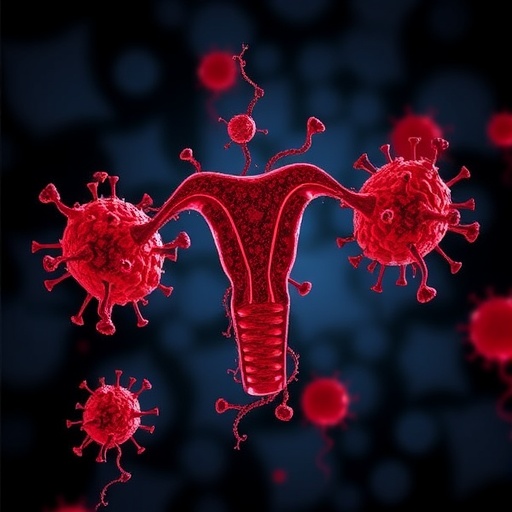Reston, VA (January 11, 2024)—A newly developed PET imaging agent has been found to be effective in identifying medullary thyroid cancer (MTC) in preclinical and clinical studies, according to research published in the January issue of The Journal of Nuclear Medicine. The results of the studies indicate that the PET imaging agent may be a promising theranostic candidate for clinical use.

Credit: Images created by M Kircher and C Lapa, et al., University Hospital Augsburg, Augsburg, Germany.
Reston, VA (January 11, 2024)—A newly developed PET imaging agent has been found to be effective in identifying medullary thyroid cancer (MTC) in preclinical and clinical studies, according to research published in the January issue of The Journal of Nuclear Medicine. The results of the studies indicate that the PET imaging agent may be a promising theranostic candidate for clinical use.
MTC is one of the rarest forms of thyroid cancer and accounts for approximately three percent of all cases. Since MTC originates from different cells than most thyroid cancers, different imaging and therapy targets are needed for these patients.
“The cholecystokinin-2 receptor (CCK-2R) is overexpressed on most MTC cells and various compounds targeting CCK-2R have been developed over the past several years. Most of these compounds, however, have low metabolic stability, which is not ideal for radioligand therapy,” noted Thomas Günther, PhD, pharmaceutical radiochemist at Stanford University in Stanford, California. “With a simplistic design modification to tackle instability issues, our team created multiple theranostic agents and sought to evaluate their effectiveness.”
In the study, three compounds (DOTA-CCK-66, DOTA-CCK 66.2, and DOTA-MGS5 external reference]) were each labeled separately with 64Cu, 67Ga, and 177Lu. CCK-2R affinity of each of the radiolabeled compounds was examined on MTC cells. All three compounds exhibited a high affinity, however, due to the more favorable in vitro properties overall of DOTA-CCK-66, DOTA-CCK-66.2 was excluded from further studies.
Next, in vivo stability, biodistribution, imaging, and competition studies were performed on mice bearing a CCK-2R-expressing tumor. 68Ga-DOTA-CCK-66 was selected for proof-of-concept PET/CT application based on its overall in vitro and in vivo properties.
Two MTC patients then underwent 68Ga-DOTA-CCK-66 PET/CT. The compound was well tolerated, showed a favorable biodistribution, and demonstrated high accumulation of activity in tumors.
“Due to increased in vivo stability, our compound reveals favorable tumor uptake as well as an improved activity clearance from off-target tissues. This could result in enhanced lesion detection in PET imaging and additionally enable targeted MTC radioligand therapy,” said Constantin Lapa, MD, director of nuclear medicine at University Hospital Augsburg, in Augsburg, Germany.
Günther and Lapa added, “A significant outcome of our work is the notion that it is possible to optimize pharmacokinetics by chemical design. Analyzing weaknesses of existing compounds and then systematically addressing those to improve imaging and treatment is crucial for future clinical translation.”
This research was published online in November 2023.
The authors of “Preclinical Evaluation of Minigastrin Analogs and Proof-of-Concept [68Ga]Ga-DOTA-CCK-66 PET/CT in 2 Patients with Medullary Thyroid Cancer” include Thomas Günther, Nadine Holzleitner, Roswitha Beck, and Hans-Jürgen Wester, Department of Chemistry, Chair of Pharmaceutical Radiochemistry, TUM School of Natural Sciences, Technical University of Munich, Garching, Germany; and Oliver Viering, Georgine Wienand, Alexander Dierks, Christian H. Pfob, Ralph A. Bundschuh, Malte Kircher, and Constantin Lapa, Nuclear Medicine, Faculty of Medicine, University of Augsburg, Augsburg, Germany.
Visit the JNM website for the latest research, and follow our new Twitter and Facebook pages @JournalofNucMed or follow us on LinkedIn.
###
Please visit the SNMMI Media Center for more information about molecular imaging and precision imaging. To schedule an interview with the researchers, please contact Rebecca Maxey at (703) 652-6772 or [email protected].
About JNM and the Society of Nuclear Medicine and Molecular Imaging
The Journal of Nuclear Medicine (JNM) is the world’s leading nuclear medicine, molecular imaging and theranostics journal, accessed 15 million times each year by practitioners around the globe, providing them with the information they need to advance this rapidly expanding field. Current and past issues of The Journal of Nuclear Medicine can be found online at http://jnm.snmjournals.org.
JNM is published by the Society of Nuclear Medicine and Molecular Imaging (SNMMI), an international scientific and medical organization dedicated to advancing nuclear medicine and molecular imaging—precision medicine that allows diagnosis and treatment to be tailored to individual patients in order to achieve the best possible outcomes. For more information, visit www.snmmi.org.
Journal
Journal of Nuclear Medicine
DOI
10.2967/jnumed.123.266537
Article Title
Preclinical Evaluation of Minigastrin Analogs and Proof-of-Concept [68Ga]Ga-DOTA-CCK-66 PET/CT in 2 Patients with Medullary Thyroid Cancer
Article Publication Date
1-Jan-2024
COI Statement
Thomas Günther received the 2023 Sanjiv Sam Gambhir–Philips and the 2023 Translational Research and Applied Medicine fellowship for support at Stanford University. A patent application on CCK-2R–targeted compounds including DOTA-CCK-66 with Thomas Günther, Nadine Holzleitner, Constantin Lapa, and Hans-Jürgen Wester as inventors has been filed. Hans-Jürgen Wester is founder and shareholder of Scintomics GmbH, Munich, Germany.




